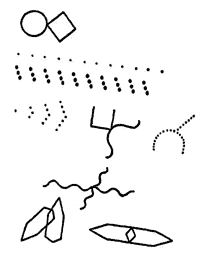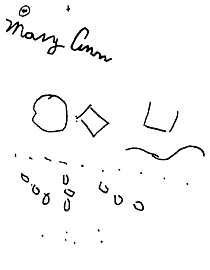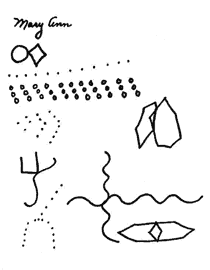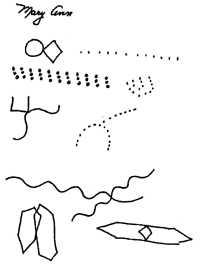Vital Facts about Dyslexia and Other Disorders
Medical Treatment of Major Disorders Combined With Dyslexia
Mental Retardation (MR)There is no known medical help for Mental Retardation. However, my CVS research has demonstrated that the vast majority of individuals with MR also have dyslexia and related CV dysfunction. As a result, by treating MR individuals with CVS-enhancing medications, there can be significant improvements. In other words, MR individuals with cerebral processing difficulties also have signal scrambling disturbances of CVS origin, i.e., dyslexia. By improving signal clarity, the defective cortical processors have a much easier time functioning. |
Cerebral Palsy (CP)There is no known medical help for Cerebral Palsy. However, my CVS research has demonstrated that the vast majority of individuals with CP also have dyslexia and related signal scrambling. As a result, by treating CP individuals with CVS-enhancing medications, there can be significant improvements. In other words, CP individuals with cerebral processing and related motor difficulties also have signal scrambling sensory and motor disturbances of CVS origin, i.e., dyslexia. By improving signal clarify, the defective cortical and related (CNS) central nervous system processors have a much easier time functioning. |
AutismMany researchers have reported cerebellar deficits in autism — and some believe this disorder is of cerebellar origin. My experiences have led me to think otherwise. The language disorder in autism appears to have a cerebral or thinking-brain quality. But since the cerebellum is also involved, by treating autism with CVS enhancing medications there often results overall improvements — even though the basic autistic mechanisms may still be evident. Some improvements, however, are infinitely better than none. |
Alcoholism / Substance-Abuse / Criminal Acting-OutBecause of the cognitive fog and predisposition to severe anxiety and panic, many CVS-dyslexics have chronic feelings of stupidity and ugliness. Many drop out of school, and drift into alcoholism, drug abuse, and criminal behavior. Once again, recognizing and treating the hidden inner-ear/cerebellar cause of these disorders can be lifesaving to many. This is especially so if a valid diagnosis is made early and treatment begun before lives are destroyed. |
Multiple SclerosisBecause many with MS also have CVS dysfunctioning, a significant number can be helped symptomatically with CVS-enhancing medications similar to those given dyslexics. |
DeafnessIndividuals with repeated middle-ear infections as well as impaired 8th or auditory nerve functioning very often evidence slight or hidden inner-ear dysfunctioning. This co-existing impairment results because the auditory and inner-ear nerve are like Siamese twins. And so damage to one often injures the adjacent other. For example, when there is hearing loss due to 8th nerve damage as well as CV-determined auditory perceptual scrambling of the limited acuity input, improving the scrambling may lead to significant overall improvement in processing the speech of others. As a result, patients suddenly recognize language patterns that before were scrambled and thus not understood. Without proper diagnosis and treatment, their real IO's appear low — a condition called by Levinson "pseudo retardation." |
Whiplash/Post-Concussion StatesSince the neck is an integration center for the inner-ear and thus the CV system, whiplash and even post-concussion states will often result in dyslexic-like symptoms associated with impaired balance/coordination, reading, memory, and concentration. As a result, early CV-based diagnosis and treatment may result in improvement until further compensation occurs. |
Brain InjuryDiffuse brain injury and trauma often affects the cerebral cortex and thinking-brain. But most often the CVS is also silently impaired — resulting in a mixed organic brain syndrome. As a result, the use of CVS-enhancing medications often results in overall improvements. |
Infectious DiseasesRepeated middle-ear infections and mononucleosis (Epstein-Barr virus) frequently lead to acquired dyslexic and ADD states. Early diagnosis and CVS therapy may result in significant improvement. |
Pervasive Developmental Delay (PDD)PDD may either represent a severe dyslexic/ADD state or more likely — a mixed CVS and other CNS disorder. Once again, proper diagnosis and effective treatment with CVS-enhancing medications often leads to significant help. |
Psychosomatic-like DisordersHeadaches in children are most commonly caused by the CVS dysfunction in dyslexia. The same is true with bedwetting, dizziness, vague abdominal complaints, nausea, vomiting tendencies, poor heat/cold tolerance, excessive sweating, and even Raynaud?s-like phenomena. Dysautonomia or disturbances in the autonomic nervous system may even lead to erectile or sexual dysfunction (for these reasons, Viagra and Prostaglandin are helpful) and eating disorders (i.e., anorexia and bulimia). Also Dyslexia and/or its resulting emotional stressors may complicate peptic ulcers in children and adults. Once again, proper holistic diagnosis and treatment may lead to more rapid and significant benefits. |
Muscle Tone DisturbancesPoor or asymmetric muscle tone of the eyes may complicate strabismus. A similar disturbance of the body muscles may intensify those predisposed to scoliosis. Low or poor muscle tone of the feet may lead to pes planus or flat feet. Double jointedness as well as all the above hypotonic disorders may be caused by a CVS dysfunction and be helped by proper treatment. |
Down's SyndromeThe hypotonia or low muscle tone and the CVS-related signal-scrambling sensory-motor symptoms in this primary cerebral disorder can be helped by CVS-enhancing medications. |
Developmental Sensory/Motor and Language or Speech DisordersMost of the above developmental disorders in children are due to CVS dysfunctioning and respond favorably to CVS-enhancing medications. These variously named disorders (visual/auditory perceptual disturbances, apraxia, dyspraxia, dysphasia, dysnomia, accident proneness, balance disorders, etc.) should be considered part and parcel of the Dyslexic Syndrome. |
Post-Neurosurgical SyndromesA variety of CVS dyslexic and ADD syndromes arise following neurosurgical procedures. Not infrequently, CVS-enhancing medications can be helpful by compensating for part of the overall CNS impairment. |
Dramatic Improvements in Major Brain Disorders

Click to enlarge
Figure A. Patients are asked to draw this diagram when they visit Dr. Levinson for the first examination.

Click to enlarge
Figure B. Patient Mary Ann's first drawing prior to medication.

Click to enlarge
Figure C. After two months of medication.

Click to enlarge
Figure D. Almost a year after her first visit, her writing and drawing were much improved.
